Viggo Mortensen has parlayed film stardom into the life of a hard-working, bohemian-minded gentleman scholar. His Lord of the Rings fees financed Perceval Press, which publishes books of poetry, photography and anthropology by himself and others, and Mortensen’s extensive discography as a musician.
The company is named after a favourite knight in the legend of King Arthur, and there is something honourably chivalric in Mortensen’s life and work, filtered through socially open-minded acceptance of the modern world. His hard-riding, brooding Aragorn in the Lord of the Rings trilogy (2001-03) opened doors, and his rangy physicality and chiselled Nordic features are a striking factor in his career, but a gentle, searching intelligence navigates it. His morally poisoned academic in pre-war Nazi Germany in Good (2008) is as memorable as his paternal protector in the post-apocalyptic The Road (2009). His four Cronenberg films range from brutally efficient carnage in A History of Violence (2005) and Eastern Promises (2007) – the latter’s nude steam-room battle and all – to playing Freud in A Dangerous Method (2011), and a surgeon operating on his own mutating body in Crimes of the Future (2022).
His heavy in the classically elegant Patricia Highsmith adaptation The Two Faces of January (2014) possesses thwarted, malign, canny charisma. Add, too, successive Oscar-nominations for one of several roles as complex, honourable dads in Captain Fantastic (2016), and Tony Lip, chauffeuring a sophisticated black pianist across the Sixties’ racist Deep South in Green Book (2018).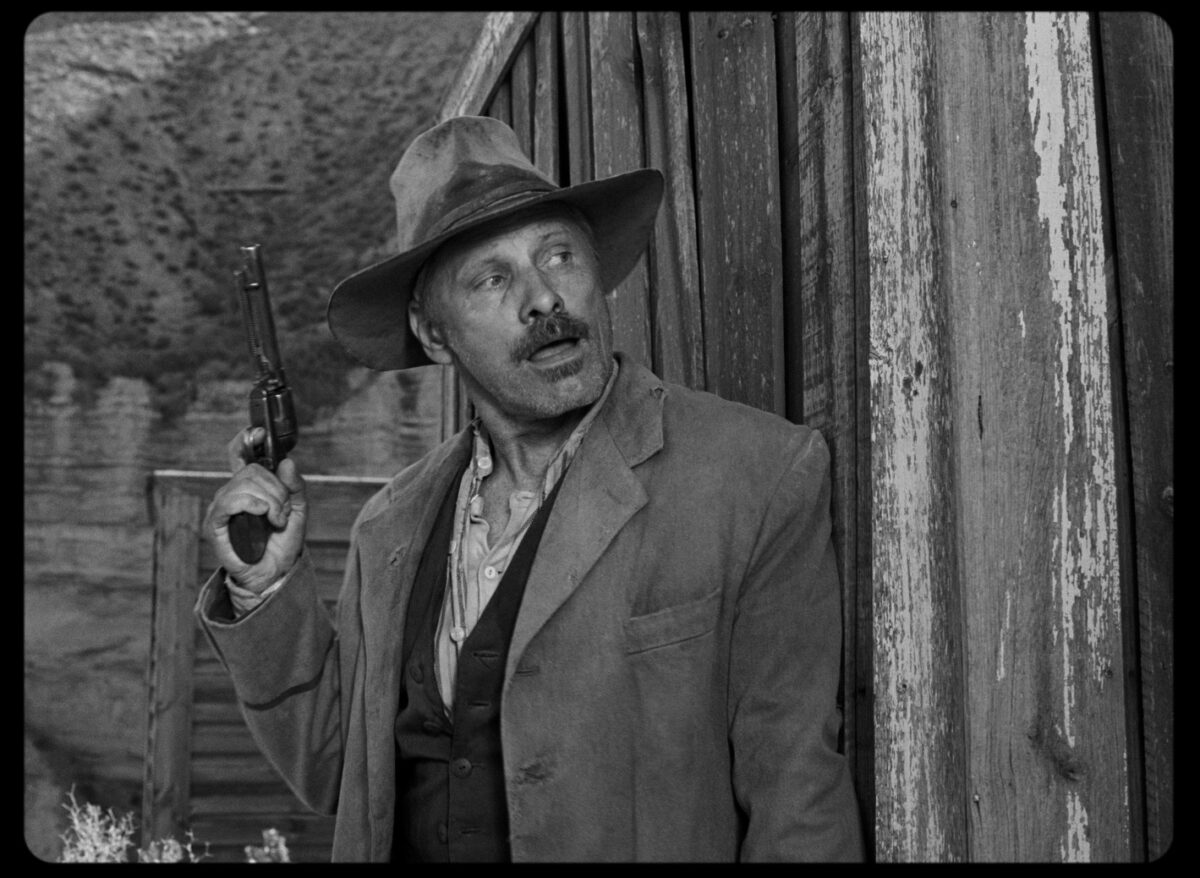 Mortensen and his two brothers were mostly raised by their Danish dad and American mum in Argentina till he was 11, when his parents divorced and his mum moved the kids to upstate New York. A childhood partly spent on horseback in the Argentine pampas perhaps accounts for the internationalised vision of the Western he’s pursued: Hidalgo (2004), as a cowboy racing a horse in Arabia, encompassing the Wounded Knee massacre and Lakota ghost-dances; with Ed Harris as frontier lawmen in Appaloosa (2008); facing down lynch mobs in Fifties Algeria in Far from Men (2014); a Danish soldier seeking his daughter across Argentina’s forbidding 19th century terrain in Lisandro Alonso’s Juaja (2014), and a gunfighter in the same director’s slow-burning, centuries-spanning meditation on Dakota life, Eureka (2024) (Mortensen, pictured above in Eureka).
Mortensen and his two brothers were mostly raised by their Danish dad and American mum in Argentina till he was 11, when his parents divorced and his mum moved the kids to upstate New York. A childhood partly spent on horseback in the Argentine pampas perhaps accounts for the internationalised vision of the Western he’s pursued: Hidalgo (2004), as a cowboy racing a horse in Arabia, encompassing the Wounded Knee massacre and Lakota ghost-dances; with Ed Harris as frontier lawmen in Appaloosa (2008); facing down lynch mobs in Fifties Algeria in Far from Men (2014); a Danish soldier seeking his daughter across Argentina’s forbidding 19th century terrain in Lisandro Alonso’s Juaja (2014), and a gunfighter in the same director’s slow-burning, centuries-spanning meditation on Dakota life, Eureka (2024) (Mortensen, pictured above in Eureka).
Mortensen meanwhile debuted as writer-director with Falling (2020), inspired by his family history and his parents' dementia, starring and composing too. Lance Henriksen’s ferocious, frightened, homophobic dad goads Mortensen as his long-suffering gay son, till a cathartic confrontation (Henriken is pictured below with Mortensen). Forgiveness, as it often does in families, draws on a deep well of early, loving memories, and the person someone once was and still is somewhere inside.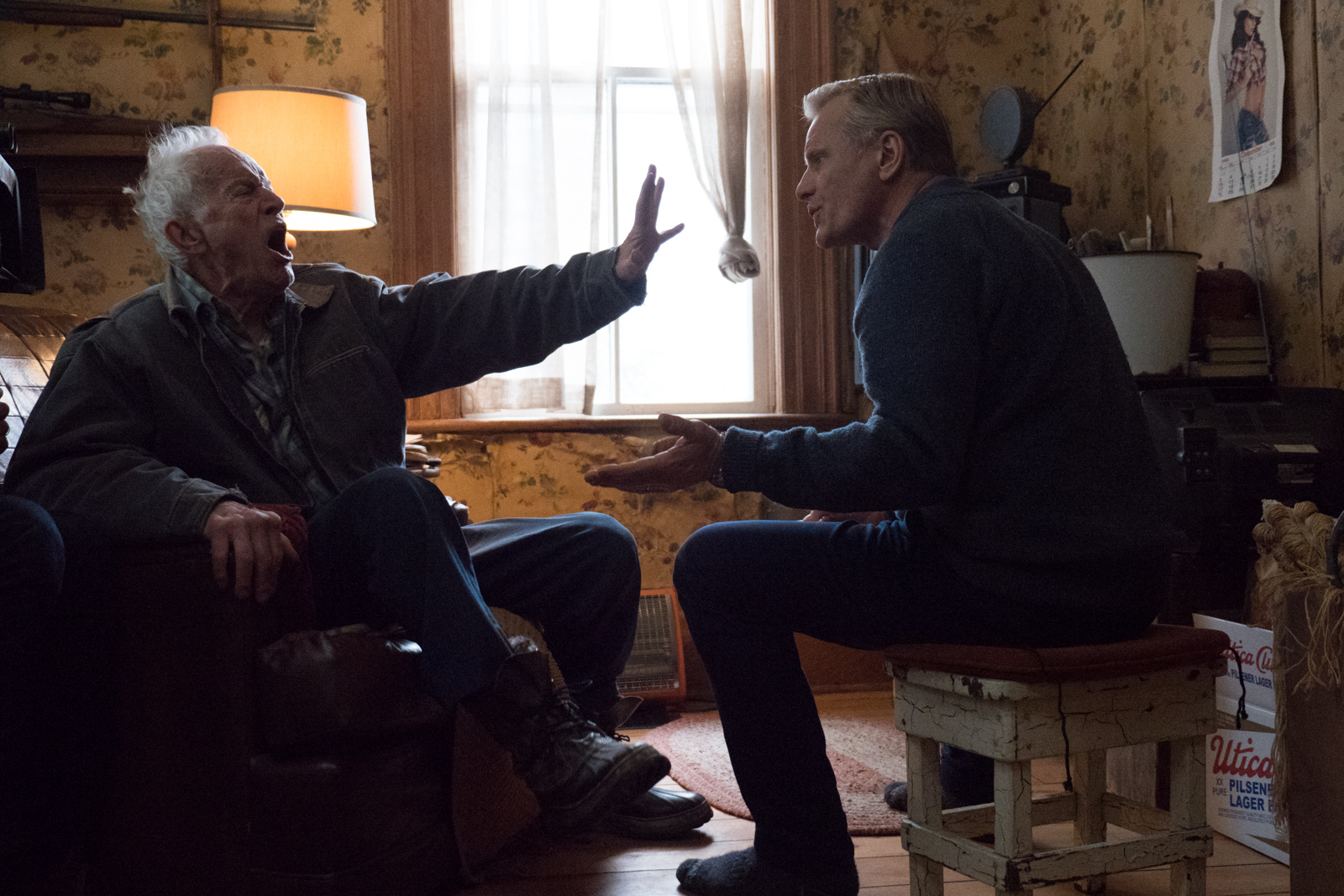 Mortensen’s new film as writer-director-star-composer, The Dead Don’t Hurt, is still more impressive. It’s a Western, set mostly in an isolated Nevada frontier town ruled by a venal mayor (Danny Huston), and terrorised by a black-garbed gunsel, Weston (Solly McLeod). Mortensen plays Olsen, a Danish Army veteran peaceably living alone, till a spark is struck with a French-Canadian flower-seller he meets in San Francisco, Vivienne (Vicky Krieps). She civilises their canyon home, which flowers into an Eden, till Olsen volunteers to fight slavery in the Civil War, and the snake Weston violently intrudes.
Mortensen’s new film as writer-director-star-composer, The Dead Don’t Hurt, is still more impressive. It’s a Western, set mostly in an isolated Nevada frontier town ruled by a venal mayor (Danny Huston), and terrorised by a black-garbed gunsel, Weston (Solly McLeod). Mortensen plays Olsen, a Danish Army veteran peaceably living alone, till a spark is struck with a French-Canadian flower-seller he meets in San Francisco, Vivienne (Vicky Krieps). She civilises their canyon home, which flowers into an Eden, till Olsen volunteers to fight slavery in the Civil War, and the snake Weston violently intrudes.
Krieps’ startling performance as Vivienne, stubbornly strong and bursting into laughter at convention’s absurdity, dovetails with Mortensen’s laconically capable, quizzical Scandinavian cowboy. As with Falling, loving forgiveness proves a hard virtue.
Both films show Mortensen and his cinematographer Marcel Zyskind’s feeling for landscape and light. The Dead Don’t Hurt is twice the film seen in the cinema, where Altman-like, murmured saloon-bar asides and the sharp clink of resigning sheriff Olsen’s tossed badge on the mayor’s desk attest to sound design matching the visual grandeur.
Mortensen, 65, meets me in the lobby of a south London hotel a stone’s throw from the Thames, bright morning sunlight from the street not quite piercing the dusky corner where he sits, sporting a flat cap over his thatch of hair. He is diligent and expansive as he discusses The Dead Don’t Hurt, his lifelong taste for adventure and culturally borderless life.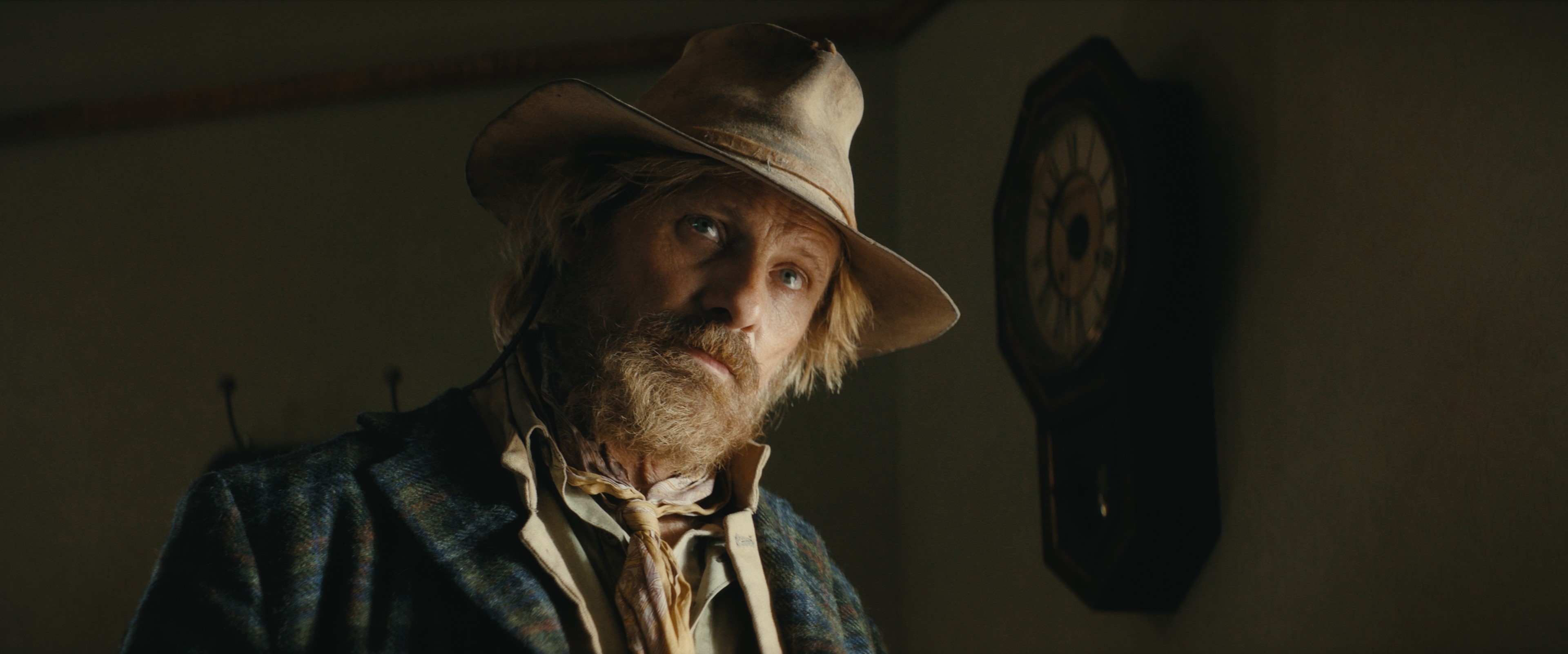 NICK HASTED: The Dead Don’t Hurt is beautiful right from the start. In the opening two, short scenes, you show Vicky Krieps’ character Vivienne die, you as her lover seen only from the back touching her, then a long pan right out behind you – then you cut to spaghetti Western carnage…
NICK HASTED: The Dead Don’t Hurt is beautiful right from the start. In the opening two, short scenes, you show Vicky Krieps’ character Vivienne die, you as her lover seen only from the back touching her, then a long pan right out behind you – then you cut to spaghetti Western carnage…
VIGGO MORTENSEN: Also one shot…
Those are jolting, unusual scenes, which seem to set out the sort of movie it's going to be.
I guess so. You wanna do something that potentially is attractive enough that people will stay with you, especially if you're gonna challenge them with the way you tell the story. And I suppose for someone who's used to seeing Westerns, it might be deceptive, you think this is gonna be a just a simple straight-ahead vengeance story. There's a desire for revenge initially, but it's a more complicated story than that.
The way it's structured is a little like Falling in that it moves through time and memories as much as space.
It's for a different reason. Falling has to do more with the fallibility of individual memory. Not just dementia, but also generally, things were never exactly as we remember them, we tailor that to our own psychological needs, and our memories of things evolve with time. What I tell you now happened when I was 10 is different than how I would've told you that when I was 25. It was about the fallibility of memory and that we need to have this record, we need to think we are the way we are because of all these things that have happened, but we don't really remember what happened accurately. In Falling it was also to get a background as to why people are in conflict now, because they were in conflict before, with what was witnessed in childhood. And in The Dead Don’t Hurt, there's some degree of that with Vivienne, the main character. You established early on that her father went off and did the same thing that Olsen ends up doing [going to war]. And what the consequences were for her and the mother, and how did they deal with it, and what was her point of view about what constitutes bravery, and what is war? Is it just military stuff or is it also what you go through?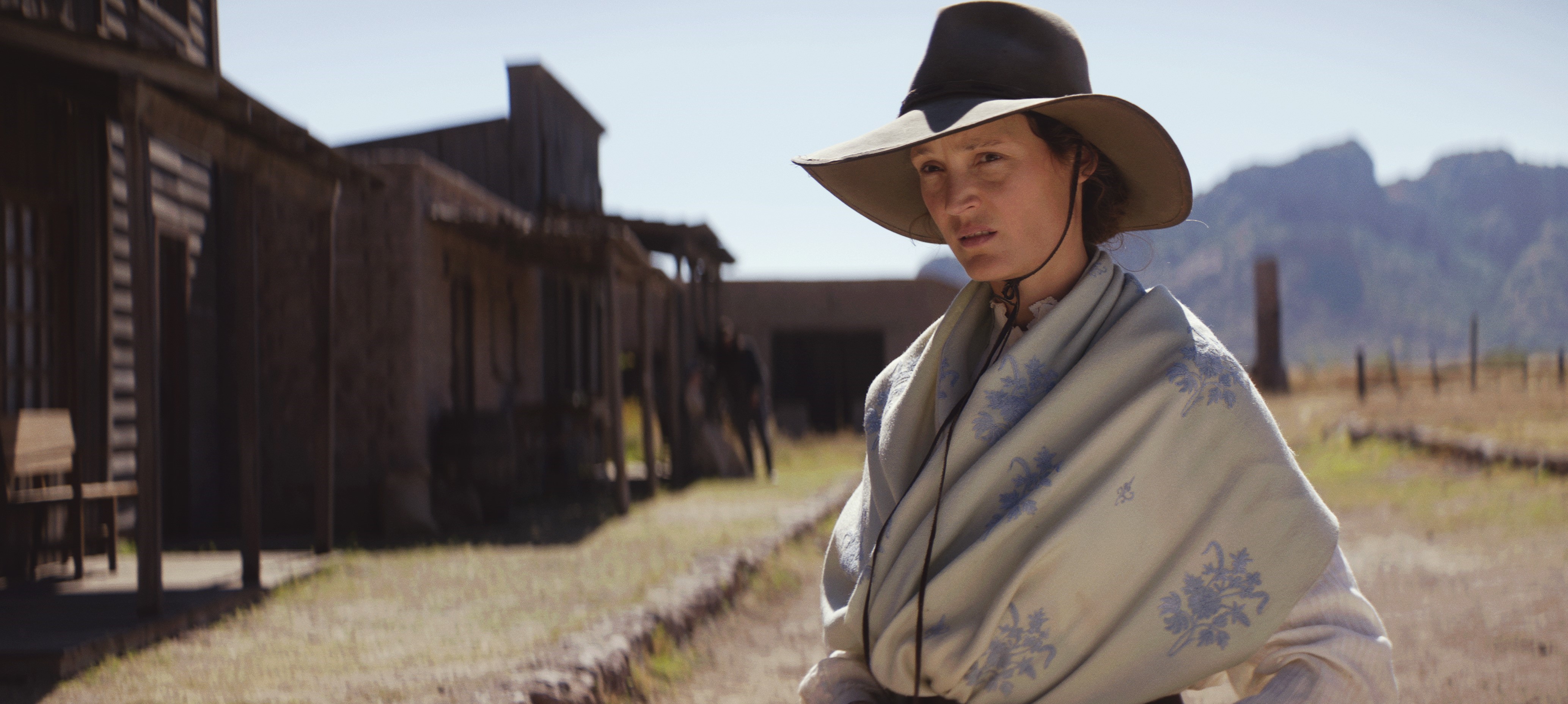 The American Civil War in this film lasts three lines, in a way. She says, ‘How was your war?’ He says, ‘Longer than I hoped. Not what I expected. How was your war?’ That's it. But everything’s in there…
The American Civil War in this film lasts three lines, in a way. She says, ‘How was your war?’ He says, ‘Longer than I hoped. Not what I expected. How was your war?’ That's it. But everything’s in there…
He has no idea what he's asking. We know. And part of the reason for the structure is that I like, as an audience member, being ahead of the characters. And when you see that first scene [of Vivienne’s death] and where she's gonna end up, you pay a different kind of attention to her life story.
You know it's finite…
It is anyway. We all are, but we don't like to think about that. But when you are shown it, immediately you're like, ‘Okay, let me see how she gets there.’ And the same with the other people who are shot in that opening scene too. You later get to know those characters because of the structure, and you find out why they had to die.
The other sliver of imagery in that opening sequence is the knight in the forest, an image from Vivienne’s childhood reading about Joan of Arc, and the last thing she sees before she dies.
Yeah, exactly. And by the end of the movie, you realise that person is different than what she initially saw as a child, and what she remembered. The knight becomes more her than anybody else.
Are there equivalents in your childhood to that Joan of Arc book that Vivienne reads, that gave you a sense of adventure, or something you could be?
I eventually read all the Nordic sagas. And as a little kid, Han Christian Andersen stories. But in terms of adventure, I remember this was around 1968 probably, or ’67 [when Mortensen was 8], Penguin put out three Henry Treece books about Vikings, and they were good. They were sort of based on history and sort of fiction, but not really. They were based on real characters in Nordic history. The first was called Viking’s Dawn, and the second one was The Road to Miklagard, which is their name for Constantinople, and then Viking’s Sunset. It came in a little box, and I was given that for my birthday. That made a big impression on me. But I also liked to read about explorers like Stanley and Livingstone, and even Robinson Crusoe survival, adventure stories. Because I was in Argentina, and at that time there were Westerns on TV and in the movies, where kids today probably play at Marvel superheroes, we played Cowboys and Indians, or Gauchos. Because kids don't limit themselves, I even imagined myself as a Lakota warrior, like Crazy Horse or something. I was a little blond-haired, blue-eyed kid but I was like, ‘Yeah, I could do that’ [which he did; after filming Hidalgo, Mortensen was essentially adopted into a Lakota family]. So explorers and adventurers and travellers and wanderers, I guess, is mostly what I was attracted to.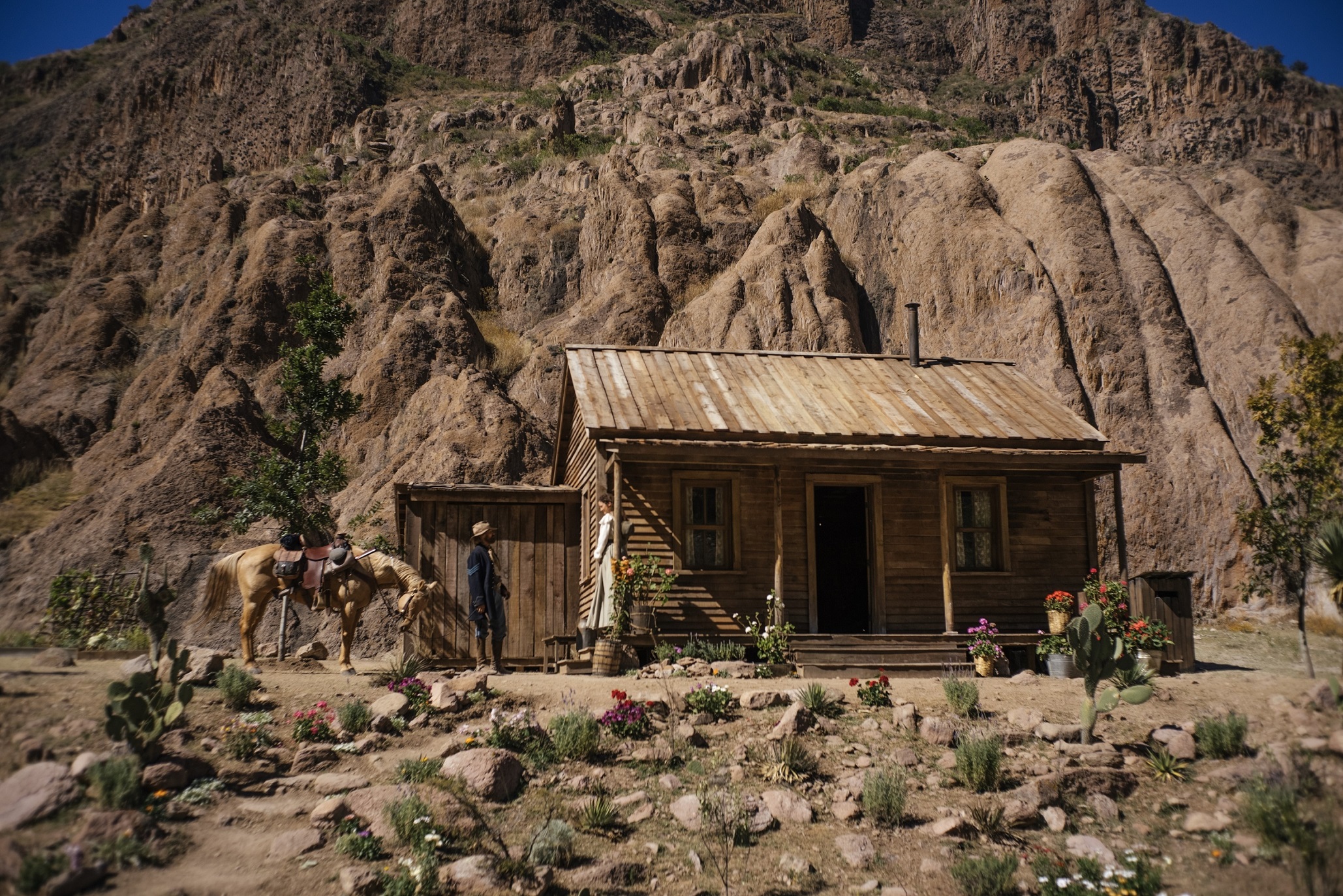 You've made a variety of Westerns. Making this one to your own specifications, was it like not only entering a genre, but entering a world, partly made of other movies, and partly of the place where you made this one, Durango?
You've made a variety of Westerns. Making this one to your own specifications, was it like not only entering a genre, but entering a world, partly made of other movies, and partly of the place where you made this one, Durango?
You always adapt a script to what you find a little bit. But the script is basically what I wrote, because I was scouting locations as I was rewriting the last bits of it and hiring people, and then you adjust to them as well. Once I realised it was a Western, it wasn't just a story of a woman, but it was putting this woman back in that time and in a place dominated by a few men who are powerful, unscrupulous and violent, to give her a bigger challenge, and then staying with her and exploring what happens to her when Olsen goes to war, that is not normal in a Western. But everything else that we tried to do was to make a classic Western that looked and sounded like one, and with a lot of attention to historical accuracy. In terms of the weapons that you see, it was a few years before the easier to operate pistols, Colts and all these things that you think of in Westerns, those are really 1880s things and this was 1861, so [shooting] was more laborious. You see that the weapons are correct, the decor, the lamps, the clothes, but also the cultural diversity, the languages. Unless you're an Indigenous person you came from many places, that was really what the West was like. And there are some things that are quite different. A female lead who’s not Barbara Stanwyck as a big ranch owner, but a normal, ordinary woman, who's not gonna overpower the bad guys physically, but she's psychologically stronger than they are. That's what's unique about her and the presence that she has, and her interior strength. And staying with her, and the two leads not having English as their first language, these things are quite different in a Western. But the look of it is like a classic Western, I think.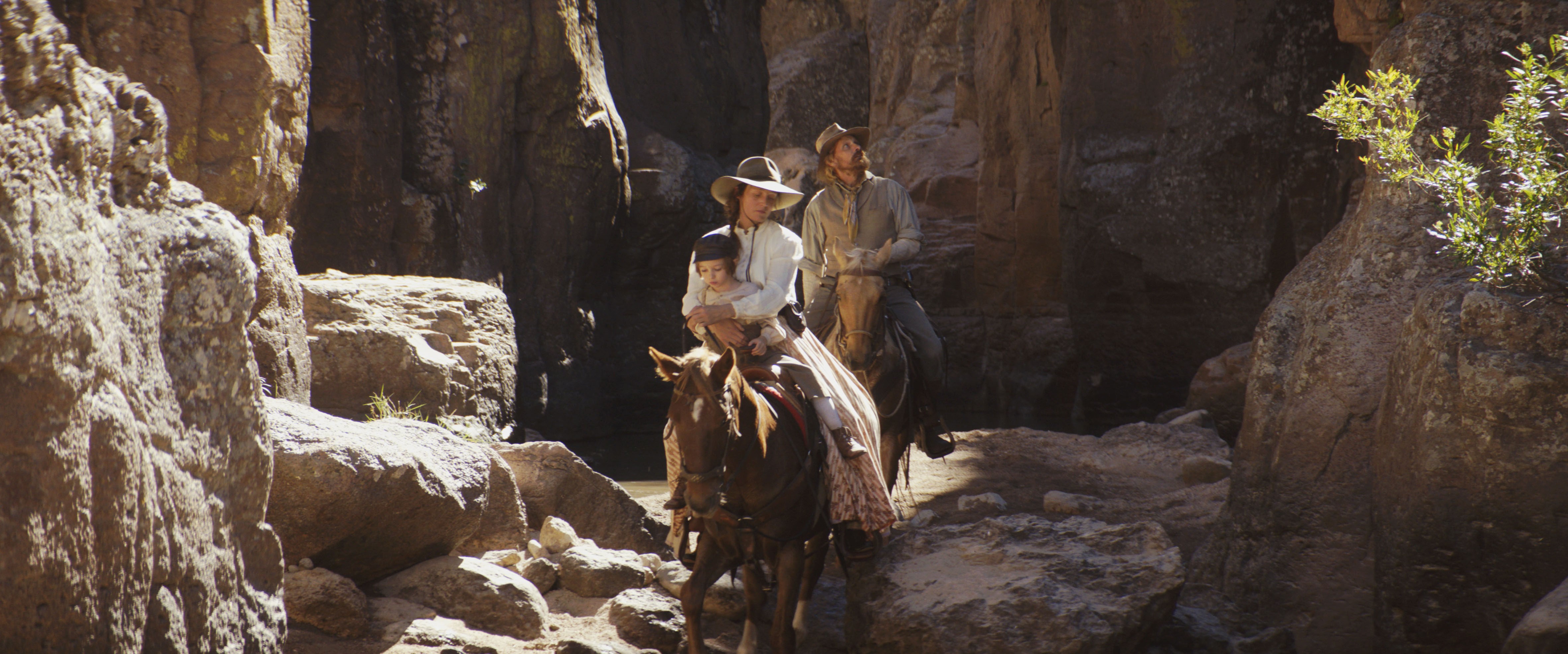 Olsen and Vivienne’s accents set them apart, although as you say, so many people were coming from elsewhere. When you moved between different countries as a child, did your accent and your background set you apart?
Olsen and Vivienne’s accents set them apart, although as you say, so many people were coming from elsewhere. When you moved between different countries as a child, did your accent and your background set you apart?
Well, in Argentina, where I spent most of my first decade, I sounded like any other kid there. Only once in a while someone would throw a jibe at me just 'cause I looked different than them. I was very fair-haired and blue-eyed, like my brothers. But generally, I just fit in and seemed like any other kid there. But then when I was 11, I went to the US. Even though it's the country of my birth, and I spoke English as I speak it now, I had a different point of view on certain things, or my reactions were different. I didn't have the same familiarity with the things that kids there knew. The world wasn't as globalized. Even though we were seeing American series on TV, they were dubbed into Spanish, and when I saw cartoons on television in the US, I was surprised to hear it in English. I was like, ‘Oh, I thought this was an Argentine thing.’ And it's only in the US that colour’s spelled ‘color’, for example. And so I would have my papers marked down. Those are minor things, but I remember every morning I had to stand up and pledge allegiance to the flag of the United States. And I thought, ‘Wow, that's very bizarre.’ But it's no stranger than in Argentina, when at the end of each school day we had to sing the Argentine anthem. And then there was a period of about two years where I was at a school where there was an English influence, so we had to sing the national anthem of Argentina, and then “God Save the Queen” as well. All of that I found bizarre then. I had a different perspective and felt like a bit of an outsider there, that's for sure. And I guess everywhere I've gone, because of my itinerant life, I feel mostly it's not where you are, it's how you are, how you relate to people. Trees are trees, people are people, and flags are interesting, but they're not the be all and end all
Not necessarily something to worship…
Yeah. I see the dangers of patriotism and nationalism and being blinkered about things. And I'm concerned about that. And not just in the United States, but everywhere else. We have more ability to communicate with each other than ever. And yet I think in my lifetime, this is the most closed-off and compartmentalized and divided that I've seen society, since the Sixties, Seventies in the US. And I see the same thing in this country. I see the same thing in Spain and France. It's disappointing.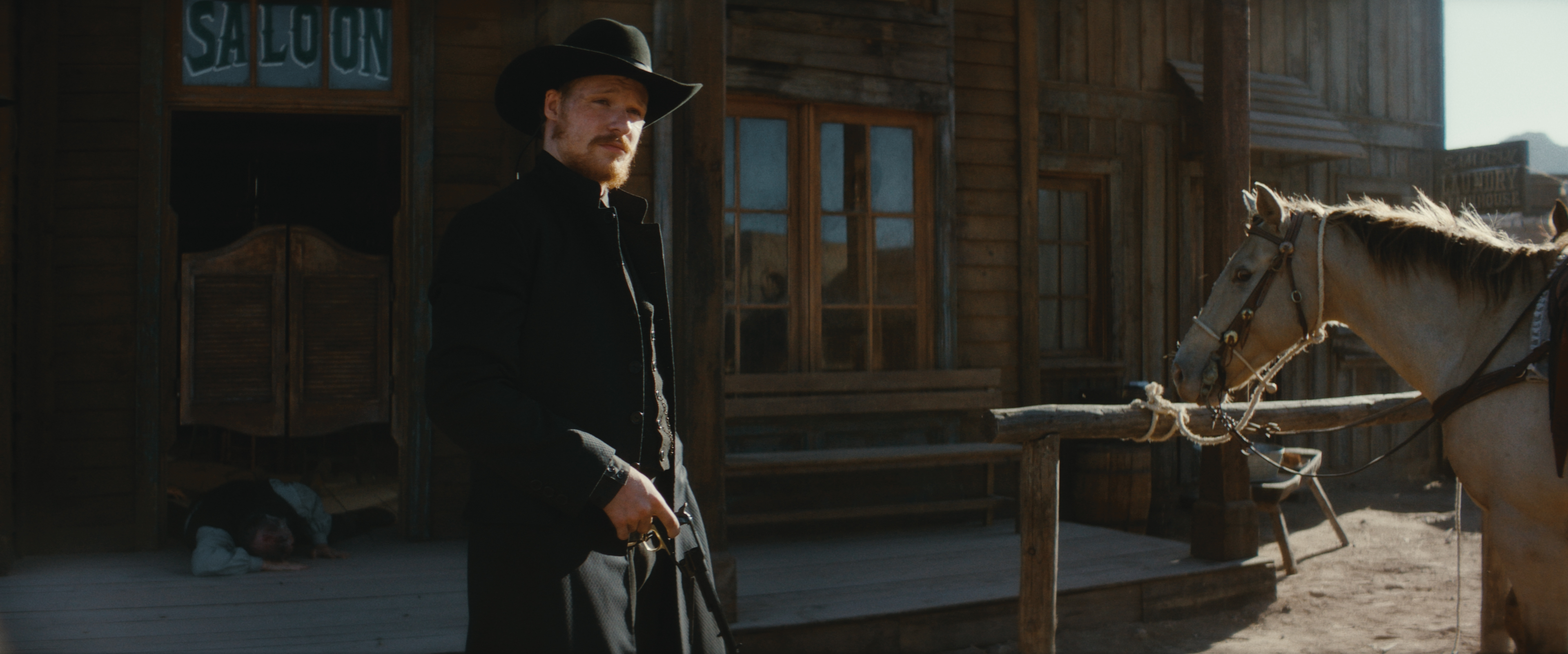 Vivienne and Olsen are also literally set apart from everyone else.
Vivienne and Olsen are also literally set apart from everyone else.
Yeah. They're up in this canyon...
And there's something about the canyon, with those mountains looming over them. It’s dwarfing them, but also expanding them…
Yeah. They're protected and it's a nice place to be together. But then it's quite different when he leaves, then she's exposed and isolated. And so, again because of the structure, when Weston [Solly McLeod, pictured above] comes to visit, and she's gardening, she keeps him at a polite distance because she's seen him a couple times in the saloon, she knows he's an arrogant, conceited kind of person. But we know a lot more, he is a vicious killer and very dangerous. And when she offers to get him a cup of tea, we think, ‘Oh God, no, don't have tea with him!’ But she can't know what we do.
Vivienne’s a woman who, as with women now, will be abused by men, but remains unbowed. What did Vicky Krieps give to the character that you had written?
Well, one of the things that she does very well is she communicates. It's a feeling there's something happening. Maybe you’re not sure what, but in silence, she has a very good presence on screen. Part of that’s skill. But part of it's just luck, in a way, and it's unfair, but on movie screens there are excellent actors, the best, who don't have that. She has that mysterious thing. I remember the first time I saw her, in Phantom Thread, it reminded me of when I first saw Meryl Streep. Like, wow, there's a lot going on here. I don't really feel like taking my eyes off her, even when someone else is speaking,
Something you haven't quite seen before…
Yeah. What's happening? I'm not sure what, but something's going on. So I thought, if she does the role, it'll be great. Because she can feel those silences. I will believe that she's from that era. Fortunately she said yes.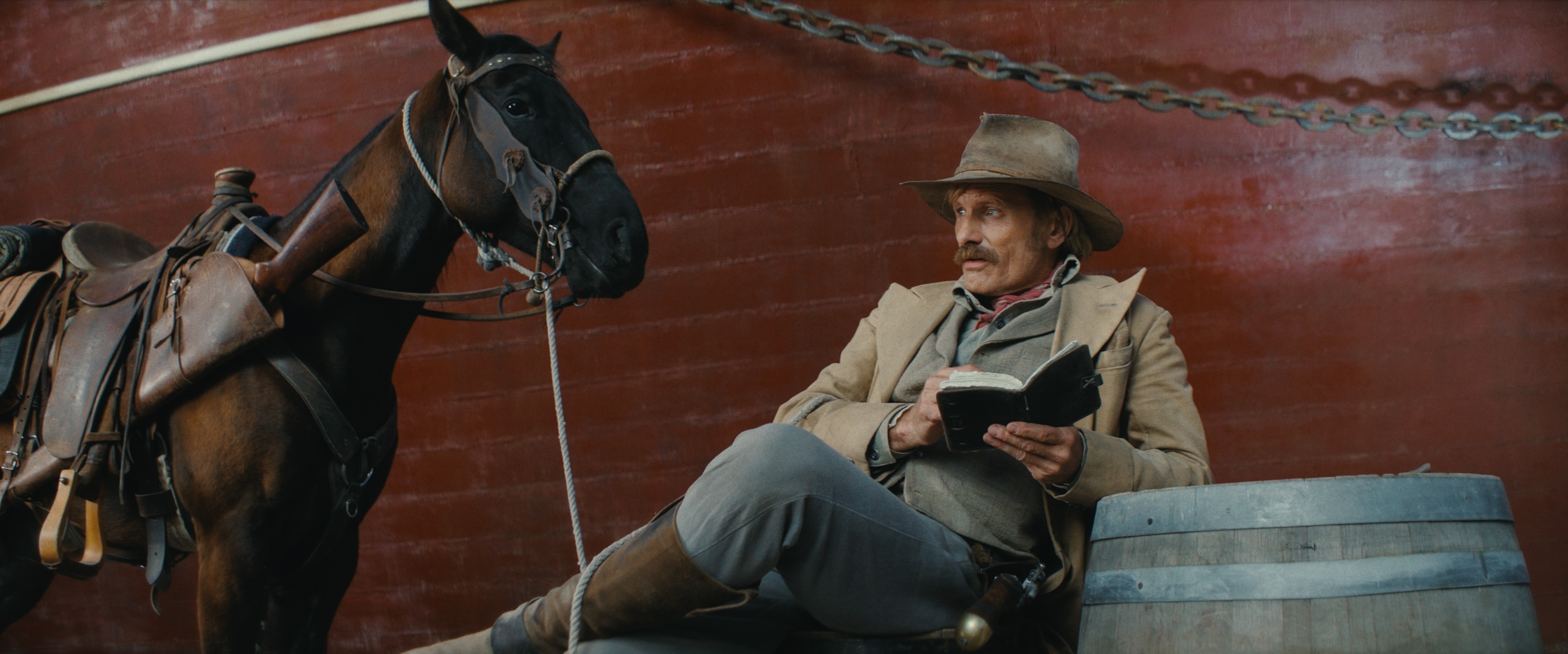 What do you think Olsen is writing, when you show him doing so in spare moments?
What do you think Olsen is writing, when you show him doing so in spare moments?
Part of it is travel journals. When Vivienne first sees him, he's got a notebook and he is describing the place he's in, the people of San Francisco. And when he's sitting in the morning after coming home [from the war], it's like a diary, he's writing about having come home. He writes those things in his notebook in pencil. But in the evening, when he's writing with the quill pen, he's writing out a long poem.
Is that his closest point to you – naturally writing, whenever you get the chance?
Yeah, maybe. But before I knew I was gonna play him – 'cause it was gonna be another actor for a long time – he had the notebook, and he was writing. Most of what was originally there before I ended up playing him remained, he was just younger, so he would've written in a different way, probably about different things. Not that you see that stuff [as a viewer] anyway, unless you can read Danish long-hand! But him being older adds several layers that weren't there. I could add the thing about him having fought in the [Danish-Prussian] Three Years war a dozen years earlier. And there's a more settled quality with age as far as how he relates to her and the fact that he's curious about her. Like she wants to get a job. He's not against it. He's open to it. And I think it changes how the relationship with the boy eventually feels, being that he's older. You take whatever obstacles are in your way and try to use them to your advantage.
As a Western hero – and you’ve played a few – he's stoic and he has that almost supernatural ability with violence, reluctantly used. But he's also really easygoing…
But he's not perfect. I mean, he shoots at Weston, and he doesn't hit him. When it really matters, he does! [flashing a grin]
Your cinematographer, Marcel Zyskind, has talked about the special, constant sunlight in Durango. Was it transporting to be there?
Yeah, very rarely did we have cloud. It was very dry, constant sun, and you got into a different rhythm. I liked that the light wasn’t always as beautiful. Sometimes it's harsh, like when I return from the war, the light is hard right there on Vicky, and even on me. It made it feel more real. And fortunately, Vicky is not a particularly vain kind of actor. There's some women who I don't know how they would've put up with the light, who might have wanted to primp more, but she played it like a real, ordinary woman. I believe she was from then.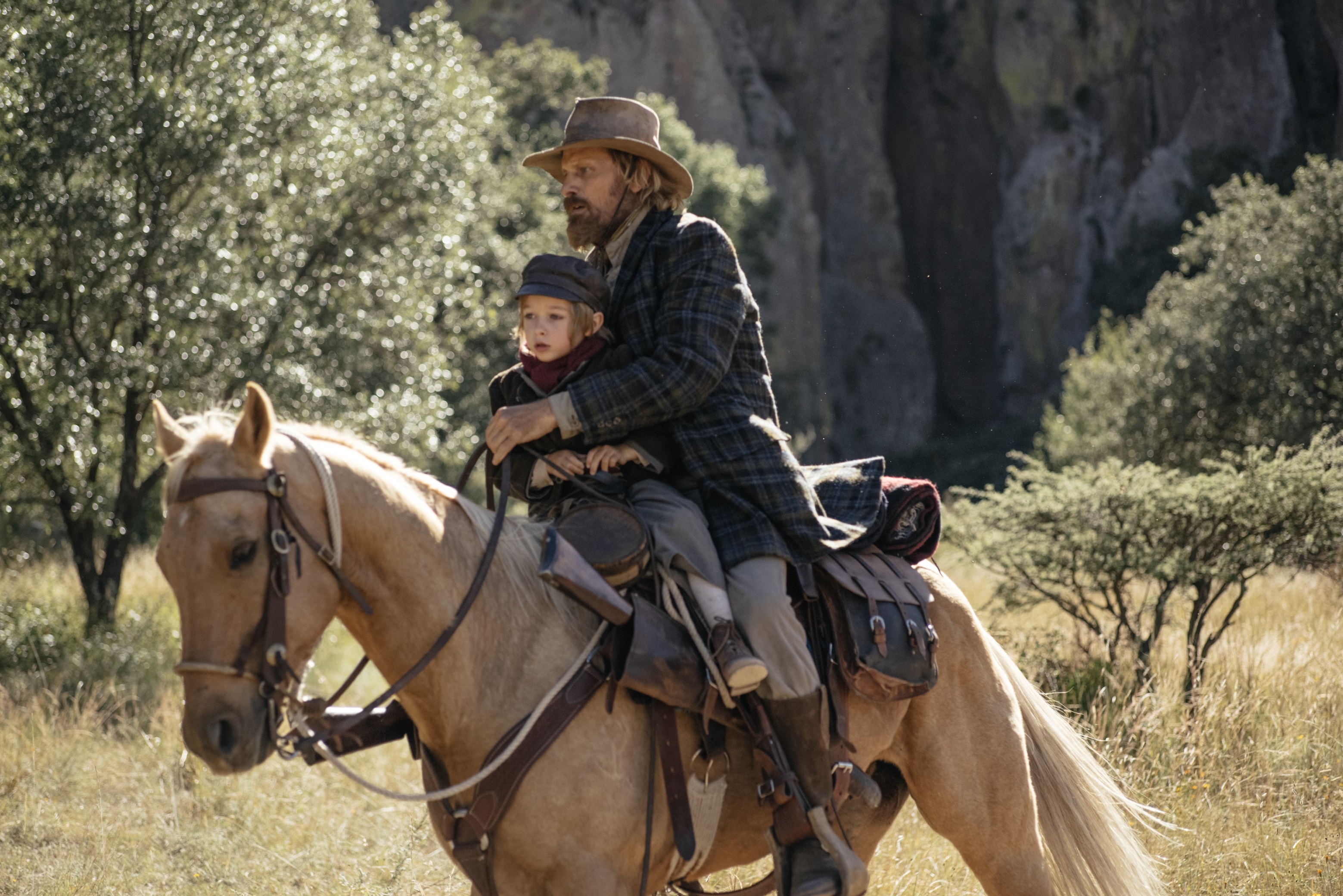 Your films as director bring together most of your own artistic modes – writing, composing, acting. Has crafting them as closely as possible to your own vision provided a different form of satisfaction – perhaps more akin to one of your poems? What have these films given you that films as an actor alone haven’t?
Your films as director bring together most of your own artistic modes – writing, composing, acting. Has crafting them as closely as possible to your own vision provided a different form of satisfaction – perhaps more akin to one of your poems? What have these films given you that films as an actor alone haven’t?
While it is true that being the director, the fact that you have the contractual right to cast, shoot and edit the way you want to – within the budget available – allows you to put your personal stamp on the finished project, it is still the product of a collective exercise. True collaboration with the cast and crew invariably challenges the director to improve on her or his original approach to constructing individual scenes and the overall story. Assuming that a production has been thoroughly prepared and the goals have been clearly communicated to the whole team, it seems to me that simply being a good listener and observer is what makes directors effective and successful when filming and editing a story. A director is an overall guide, ideally, a shepherd of the collective effort. If the work is proceeding well, the director should stay out of the way and let it flow. Step in only when absolutely necessary. Allow people to contribute, to surprise you.
I was interviewing Harrison Ford a long time ago, and he said to me that he picked roles with a sense of his responsibilities as a leading man.
Like he took into account his image, as a movie star? I don't take that into account. I mean, I think that's fine…
It seems like, rather than constricting you, Lord of the Rings’ success further freed you.
It gave me access to more directors, so [that work] was not just a pipe dream, but a possibility. If somebody thought I was right for a role, then they could say, well, he's popular now so we can cast him. Same for the other actors in Lord the Rings. It’s what you do – you hope to get lucky, but then you have to try to make the most of that lucky break or be prepared for luck when it comes along. People have this mistaken idea that when someone gets to be known as an actor, that they can do whatever they want, and they're guiding themselves. All you can do is say no to things. You can't really say yes unless they're inviting you.
But it gave you more chance to say no.
That's it, yeah. Exactly.
- The Dead Don't Hurt is in cinemas now
- More film features and reviews on theartsdesk















Add comment